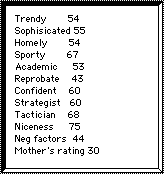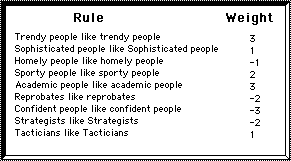
Chapter 12
Enhancing the human brain
Creating a personality
It is unlikely that single questions would be reliable guides to a person's overall personality and character, but, the average of a number of questions might be more significant. The questions were then arranged into groupings according to very broad categories. It was then very easy for a computer program to count the positive or negative responses to the questions in a particular category and give that category a score or rating. Such a record for a particular person is shown in figure 12.7, where the marks in each category are expressed as a percentile.

Figure 12.7
A generalized clone personality, arrived at by grouping the answers from the questionnaire into various categories
Once you have a clone defined in this form, it is easy to make rules relating to the categories and give weightings to those rules. This is shown in figure 12.8.

Figure 12.8
By grouping questions into categories, you can devise rules to relate those categories to attractions between different people. The relative importance of each category matching rule can be specified by giving each rule a weighting
One you have a system that can describe people by means of categories, you can set up rules of attraction (or repulsion) based upon these categories and use weightings to specify the strengths of the rules (using negative weights to reverse the rules where necessary). This can easily be translated into the form of variables that represent emotional responses to the characteristic profiles of different people. In other words, bot clones can be designed to "feel attractions" to other bot clones, analogous to the way way humans are attracted to each other, i.e., a complex set of emotions that when summed together give an overall impression of liking or not liking a person.